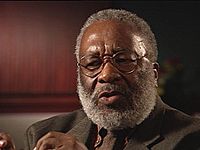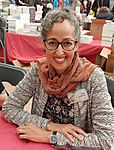Black Mennonites facts for kids
Black Mennonites are people who are both Mennonite and Black. They live in many places around the world, like Africa, the United States, and Canada. Black Mennonite groups have been around in the U.S. and Canada since the late 1800s. Today, many Mennonites live in Africa. For example, Ethiopia and the Democratic Republic of the Congo have some of the largest Mennonite populations. Other countries like Tanzania, Zimbabwe, Kenya, and Angola also have many Mennonites.
Glen Alexander Guyton, who is the first African-American leader of the Mennonite Church USA, once said that a "typical Mennonite is an African woman." This is because Mennonite missionaries shared their faith in Africa. Now, African Mennonites are even sending missionaries to Europe and the United States! While Mennonites used to be mostly people from Central Europe, Black Mennonites now make up a larger number globally. In fact, African Mennonite churches have had more members than North American ones since 2006.
Contents
History of Black Mennonites
In Canada
In 1882, Charles Jones became the first Black person to join the Ontario Mennonite Church. This was an important step for Black Mennonites in Canada.
In South Africa
Stanley Green, a Coloured South African Mennonite, became the president of the Mennonite Board of Missions in 1994. He was the first person of African heritage to hold this important role.
In the United States
In 1886, the first African American Mennonite mission was started. It was called Krimmer Mennonite Brethren and was located in Elk Park, North Carolina.
The first African Americans were baptized as Mennonite church members in 1897. Robert, Mary Elizabeth, and Cloyd Carter joined Lauver Mennonite Church in Juniata.
In 1898, the Welsh Mountain Mission was founded in New Holland, Pennsylvania. This mission worked with African Americans. Elmer Boots became the first African-American member there in 1917.
The Los Angeles Mennonite Church started in 1920. It was later renamed Calvary Mennonite Church in 1942.
Also in 1920, the Virginia Mennonite Conference discussed allowing African Americans to become members. They decided to allow Black members, but "with caution."
In the same year, Homer Church and Geneva Mercomes became the first African American students at Bethel College. This is a Mennonite college in North Newton, Kansas.
Rondo Horton became the first African American to be ordained as a minister in the Mennonite Brethren church in 1933.
In 1940, the Virginia Mennonite Conference created rules that separated church practices by race.
Juanita Lark was the first African American student to graduate from Goshen College in 1943. This is another Mennonite college in Goshen, Indiana.
In 1945, James and Rowena Lark started the Dearborn Street Mission. This mission later became Bethel Mennonite Church in Chicago.
Willis Johnson became the first African American part-time student at Eastern Mennonite College in 1948. This college is in Harrisonburg, Virginia. In 1949, Ada Webb became the first full-time African American student there.
By 1950, there were only about 150 Black Mennonites in the United States.
James Lark was the first Black person to become a Mennonite bishop. He was ordained as a minister in 1945 and as a bishop in Chicago in 1954. His wife, Rowena Lark, was also very important. She helped with outreach, told stories to children, and was a singer.
Vincent Harding, a well-known Black Mennonite and civil rights activist, gave a speech in Chicago in 1959. He spoke about race and racism. Harding was a professor and wrote speeches for Martin Luther King Jr.. In his speech, he said that racial problems are moral and spiritual issues. He also urged white Mennonites to admit past mistakes in racial discussions. He wanted Mennonites to be active in the fight against racism.
In 1960, Brother Lark became the temporary pastor at Calvary Mennonite Church in Los Angeles.
The Black Caucus of the (old) Mennonite Church was formed in 1971. This group helped Black Mennonites have a stronger voice.
Between 1950 and 1980, the number of Black Mennonites in the U.S. grew to 1,600 members. They were part of 49 Black or mixed churches.
Joy Lovett was elected as the first Black associate general secretary of the Mennonite Church in 1983.
From 1985 to 1995, the Mennonite Church worked hard to connect with city communities. Because of this effort, the number of African-American Mennonite churches grew to about 50.
Dwight McFadden became the moderator of the Mennonite Church in 1997. He was the first African-American to serve in this leadership role.
In 2015, the Calvary Community Church in Hampton, Virginia was the largest Mennonite church in the United States. This church has a history of being mostly Black.
In 2018, Glen Alexander Guyton became the first person of color and the first African-American to lead the Mennonite Church USA. He is a member of the San Antonio Mennonite Church. In the same year, about 70 Mennonites of color met in San Antonio for a conference against racism. More than half of them were Black Mennonites.
Notable Black Mennonites
- Vincent Harding was an American pastor, historian, and scholar. He is best known for working with Martin Luther King Jr.
- Sofia Samatar is an American educator, poet, and writer.
See also
- Ethnic Mennonite
- Meserete Kristos Church



